Peppers are colorful garden plants commonly cultivated for their tasty, often spicy fruits. Growing them does not have many challenges, but the main issue begins with unfavorable growing conditions, and planting them requires knowledge of the best size grow bags for peppers.
Here, we will reveal the ideal sizes of grow bags for planting the 5 types of pepper, variables to consider while planting peppers, and the best pepper to grow at home. So let’s get into it.
If you don’t want to read or don’t have time, we suggest you listen to this article.
Contents
The Best Grow Bag Size for Pepper Plants
Grow bags come in a variety of sizes to suit your needs. To produce a healthy crop, pepper plants need 3-5 gallon bags. This item, however, differs depending on the variety of pepper.
This section will go through the best grow bags for five types of peppers. Whatever type of pepper you plant should be placed in a properly grow bag for optimal welfare and productivity.
This table displays the five different types of peppers, along with the appropriate grow bag for each of them.
Green Pepper
Green peppers are essentially unripe bell peppers. Green pepper plants require a 5-gallon container because they grow to be between 18 and 24 inches across and 3 to 6 feet tall.
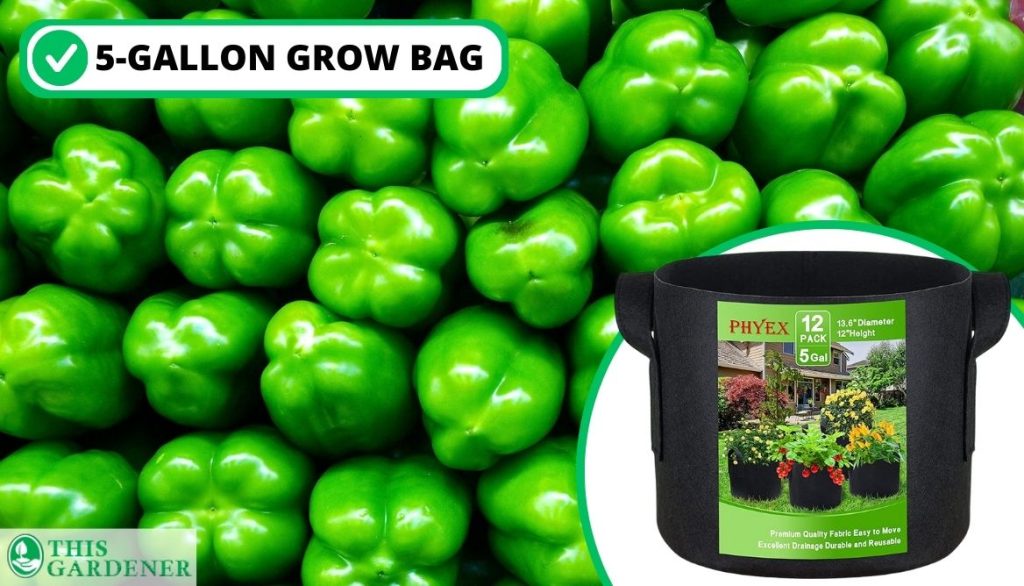
Green pepper plants are relatively large and require larger bags than other pepper kinds for optimal development and productivity.
Hot Peppers
Hot peppers have many varieties worldwide, but the main characteristic common to all is the heat or peppery flavor. Planting hot peppers need 5-gallon-size grow bags. These sizes give the plant adequate room to grow and produce more peppers during the harvest.
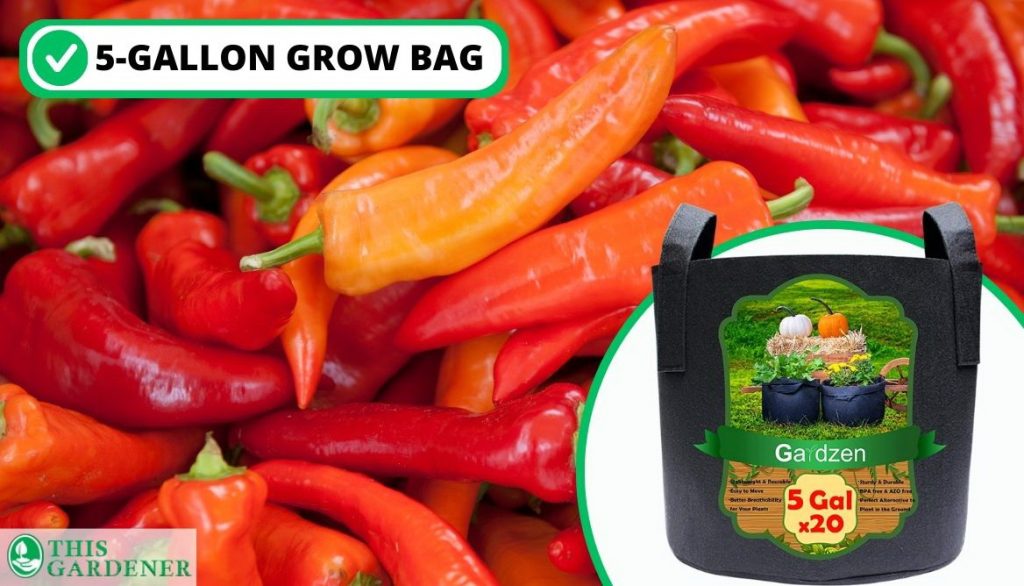
We all know when peppers are hot, but the Scoville scale (also known as the pepper scale) helps us assign a rating to them. As a result, the list in the table below is showing their degree of hotness.
Name | Scoville Heat unit (SHU) |
African Bird Eye | 175,000 |
Bahamian Chili Peppers | 95,000-100,000 |
Carolina Cayene Chili Pepper | 100,00-125,000 |
Datil Pepper | 100,000-300,000 |
Devil's Tongue Pepper | 125,000-325,000 |
Fatalii Chili Peppers | 125,000-325,000 |
Habanero Pepper | 100,000-350,000 |
Jamaican Hot Chili Pepper | 100,000-200,000 |
Tabiche Chili Pepper | 85,000-115,000 |
Madame Jeanette Chili Pepper | 125,000-325,000 |
Scotch Bonnet Chili Peppers | 100,000-350,000 |
Tiger Paw NR Chili Pepper | 265,000-328,000 |
Tshololo Chili Pepper | 80,000-120,000 |
Banana Peppers
The banana pepper is a medium-sized brilliant yellow chili pepper with a mild, acidic flavor that can change to green, red, or orange as it ripens. Banana peppers develop quite large root systems, and 5-gallon grow bags are an excellent choice.
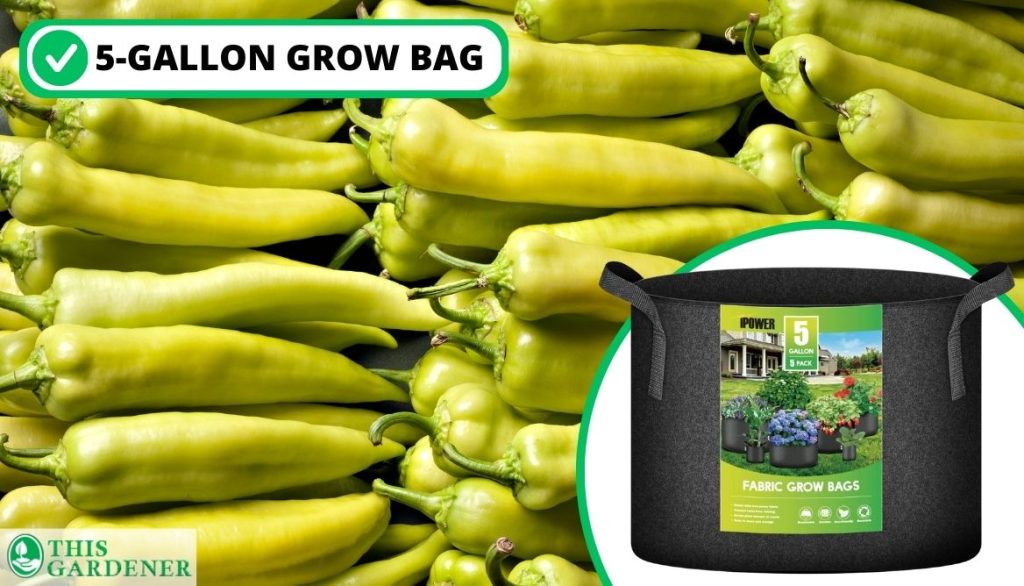
Bell Peppers
Bell peppers are linked to chili peppers and come in a variety of rainbow colors, but they lack heat and spiciness. They require close to 6 inches of soil depth to mature, hence a three Gallon grow bag is appropriate for their growth.
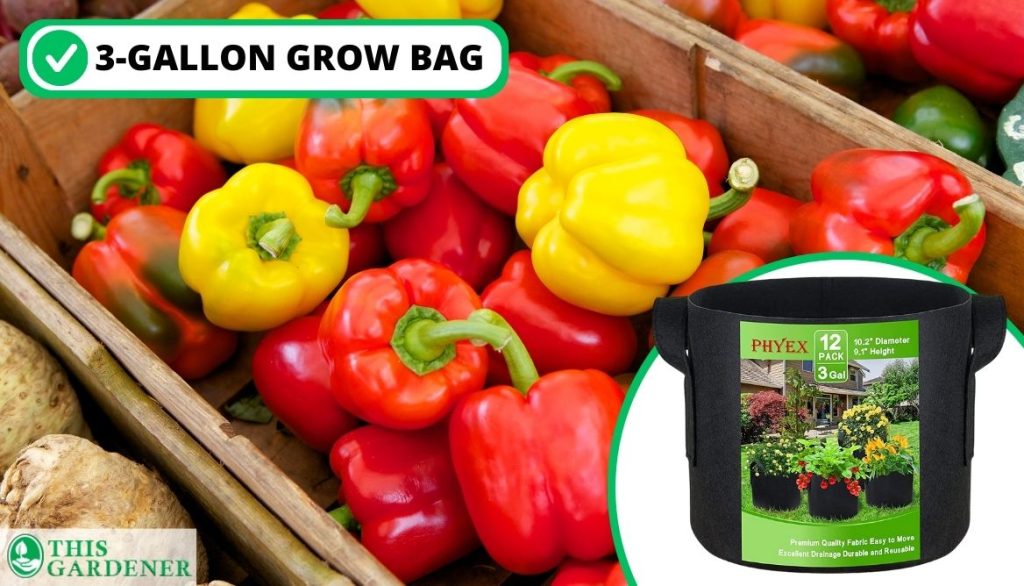
The table below illustrates varieties of bell peppers from throughout the world, each with its own distinct color.
Variants | Colour |
Ninja S10 | Red |
Heirloom Peppers | Green |
Mini Peppers (Baby Pepper) | Multicolored |
Alliance | Red |
Orange Blaze | Orange |
White Peppers | White to Faint Yellow |
Chocolate Peppers | Dark Brown |
Purple Peppers | Purple |
Sheepnose (Ohio Heirloom) | Vivid Red |
Iko Iko Peppers | Multicolored |
Pimiento Peppers | Red |
Cubanelle | Green |
Super Heavyweight | Yellow |
Jalapeno Peppers
In North and South America, the Jalapeno is the most popular chili pepper! it is medium-sized and very hot 3-inch deep-green fruit that matures to a vivid scarlet. A 3-gallon container is excellent, however, they can thrive in smaller bags but will likely produce less.
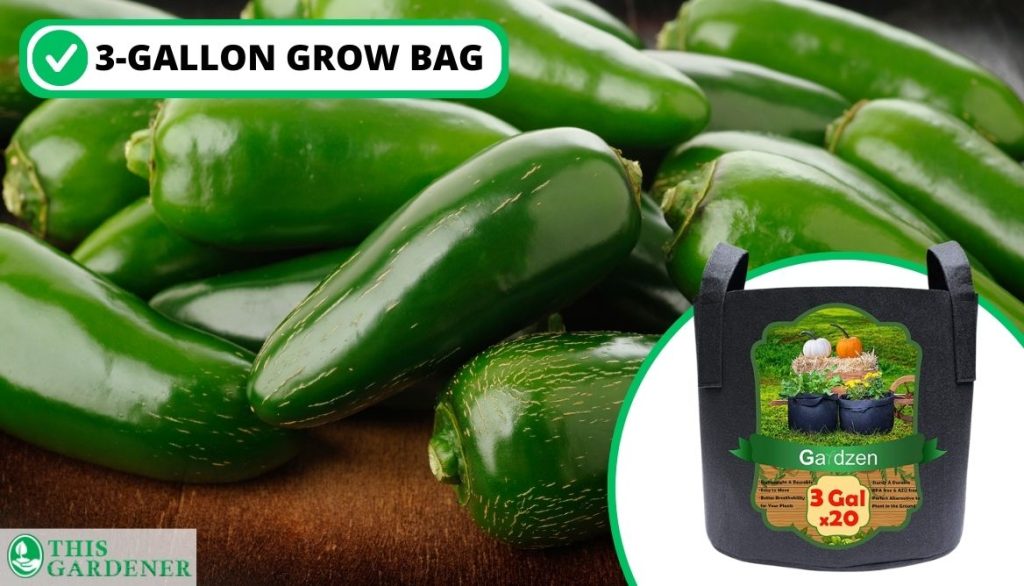
But, unless you are a gardener who likes spicy foods, you may be unaware that there are numerous jalapeno kinds available.
Varieties of Jalapeno Peppers
We’ve broken down some of the most popular Jalapeno varieties in the table below. We rate them mildest to hottest, with the majority falling within the usual jalapeno heat range of 2,500 to 8,000 Scoville heat units (SHU).
Variant | SHU |
Poblano Pepper | 1,000 to 1,500 |
Tam Jalapeño | 3,500 |
NuMex Pinata | 1,000 to 5,000 |
Mammoth Jalapeño | 1,000 to 5,000 |
Jalaro Jalapeño | 2500 to 8000 |
Chilipeño Hybrid | 2500 to 8000 |
Purple Jalapeño | 2500 to 8000 |
Purple Peppers | 2500 to 8000 |
Chipotle Peppers | 2500 to 8000 |
Chichimeca | 3,500 to 5,000 |
Conchos | 3,000 to 6,000 |
Mitla Hybrid | 4,000 to 6,000 |
Firenza | 3,000 to 8,000 |
Mucho Nacho | 4,000 to 8,000 |
Fuego/Jalafuego | 4,000 to 8,000 |
Biker Billy | 30,000 |
Jalapa Hybrid | 10,000 |
Black Jalapeño | 2,500 to 10,000 |
Disease-Resistant Pepper Varieties
Peppers grown in grow bags are tailored to the demands of the plant to promote plant development and productivity.
However, you should consider disease-resistant pepper if you can maintain most garden precautions. The following is the list:
- Jalafuego
- Banana Goddess
- Habanero
- Ninja S10
- Orange Blaze
- Super Heavyweight
- Alliance
Five Factors to Consider When Growing Peppers at Home
Pepper plants need a few considerations before planting in order to grow properly and produce a large amount of fruit. We will go over the five most significant factors one at a time.
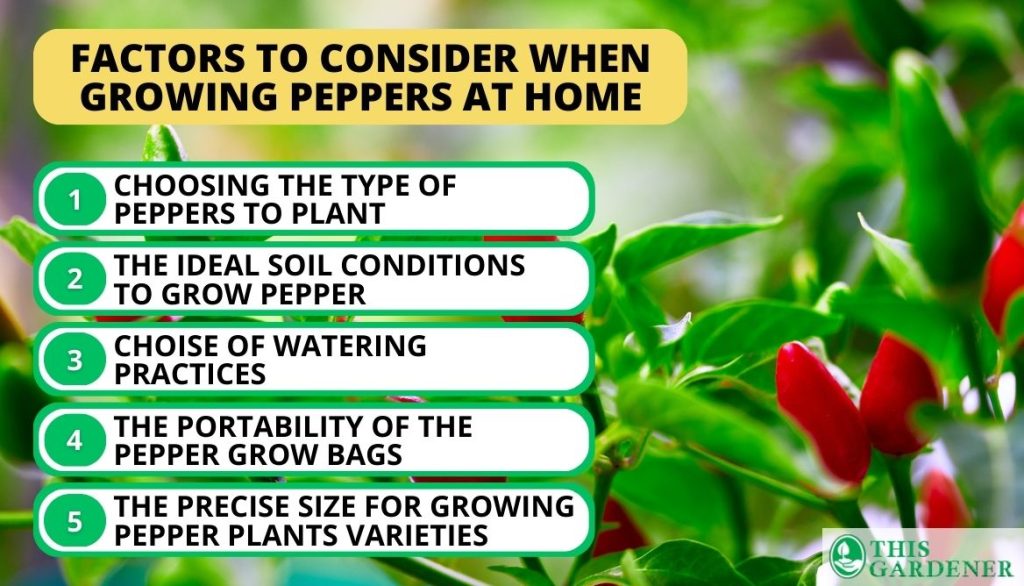
1. Choosing the Type of Peppers to Plant
One of the most significant considerations when selecting a grow bag for pepper plants is the type of pepper. It can be difficult to choose which pepper kinds to cultivate, although small and medium pepper cultivars normally produce smaller plants when matured.
Aside from flavor and heat level, you can choose pepper kinds based on color and plant size, however, Jalapeno and Habanero (hot pepper variants) are the most productive.
2. The Ideal Soil Conditions to Grow Pepper
Pepper plants flourish best in well-draining soil like loamy due to their high nutrient content, although they can also do well in compost.
However, persistent nitrogen and pH levels (soil quality) in potting soil must be maintained so that the plants do not grow too quickly.
3. Watering Practices for Pepper Plants
Before watering, it is necessary to select a frequency that is appropriate for the weather in which you are growing pepper plants.
Morning watering
You should adopt morning watering when growingpeppersin a sunny setting especially more frequent watering. This eventuality is due to the fact that early sunlight boosts the plant’s ability to absorb water faster.
Evening watering
You should water plants placed in a shady environment in the evening and also avoid excess water. Evening sunlight aids photosynthesis, allowing the plant to produce more energy from the sun.
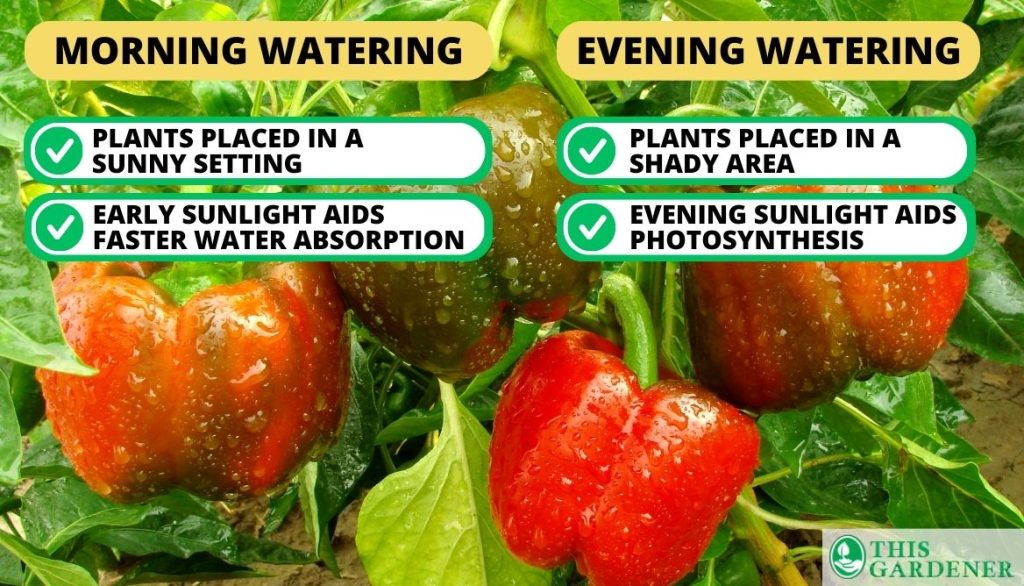
4. The Portability of the Pepper Grow Bags
Grow bags are highly portable when growing peppers, particularly when they come with sturdy handles, When planting in fabric pots or grow bags filled with garden soil, you can move them around to chase the sun, to avoid getting too much heat, or you can put them in a vehicle.
5. The Precise Size for Growing Pepper Plants Varieties
The optimal container size for pepper plants can vary depending on the kind. When growing peppers in grow bags, the size of the bag also determines the size of your plants.
- Your bag should be at least a 3-gallon grow bag for small pepper varietals and we recommend you use 5-gallon grow bags for larger ones.
- Your pepper plants will be smaller if you use a little grow bag.
- They will be larger if you use a larger grow bag filled with garden soil.
How to Grow Peppers Indoors and Outdoors
Planting peppers both indoors and outdoors necessitates the use of procedures. Peppers can be cultivated inside until they reach maturity. They can be planted outside as well, but they must first be sown indoors for a specified period before transplanting happens.
- Your Pepper seeds should be sown indoors for 6-8 weeks before transferring outside.
- Before transplanting, you should expose plants to outdoor temperatures so that they can acclimate.
- Allow plants to grow outside for a few hours each day before transferring them to the garden.
- Planting your peppers indoors demands little water, regular check-ins, and care because you have not exposed the pepper to the outdoor elements of wind, direct sun, and high temperatures.
The Best Fertilizers Ratio for Growing Peppers
The optimal fertilizer must contain the required nitrogen, phosphorus, and potassium, with NPK values of 5-5-5 or 10-10-10 when growing peppers. The ideal pH range for peppers is 6.0-6.5.
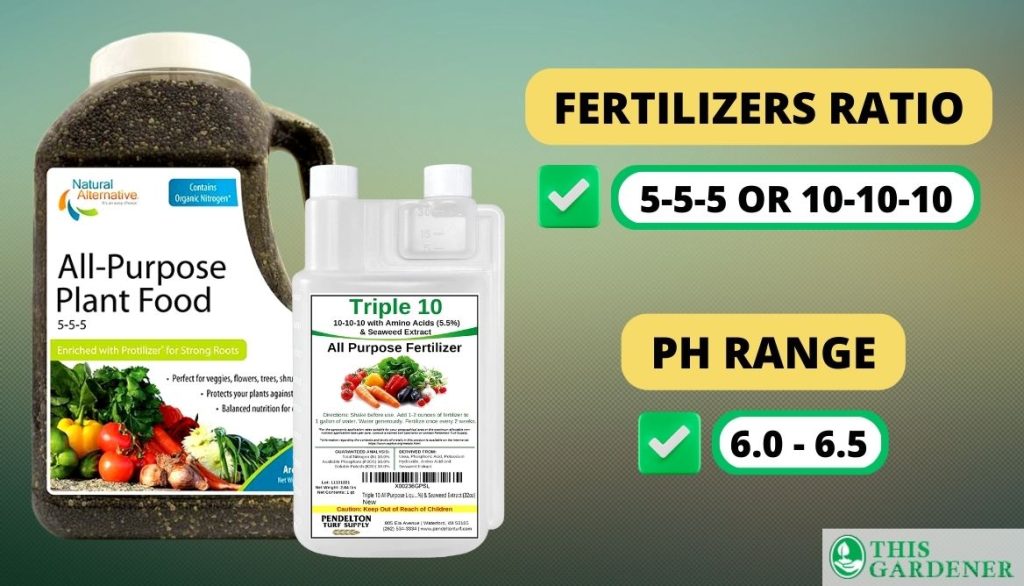
A lot of nitrogen promotes plant growth and can lead pepper plants to develop too quickly, rendering them prone to disease and less productive.
1. The Type of Compost for Fertilizing Pepper Plants
You can use any type of compost to improve soil and fertilize pepper plants. Even so, the type of compost you use in well-draining soil has a heavy effect. If nitrogen, potassium, and phosphorus are all at similar levels, they are most likely to be balanced.
2. Using Animal Manure as Fertilizer
Manure can be an efficient additional organic fertilizer in potting soil when growing pepper plants but you should manage and apply them correctly.
- Well-aged manure fertilizers from animals like livestock and cattle are abundant in nitrogen, potassium, and phosphorus, both of which aid in pepper plant growth.
- It can be quite damaging if you use fresh or large quantities of fertilizer during the plant growing season.
3. Pepper Fertilization with Fish Emulsion
Fish emulsion, often known as fish fertilizer for plants, is a fast-acting, organic liquid fertilizer derived from fishing waste.
- It is high in nitrogen, phosphorus, and potassium, which are essential nutrients for one pepper plant survival.
- Fish fertilizer also contains secondary elements such as calcium, magnesium, sulfur, chlorine, and sodium. This promotes plant growth and fruit production.
Pepper Plant Varieties for Different 3 and 5-Gallon Grow Bags
Certain pepper types produce little fruits, and you can grow these plants in smaller grow bags, most likely of the 3-gallon size grow bag variety. Most pepper types, however, require more soil for the root system to grow, necessitating larger containers.
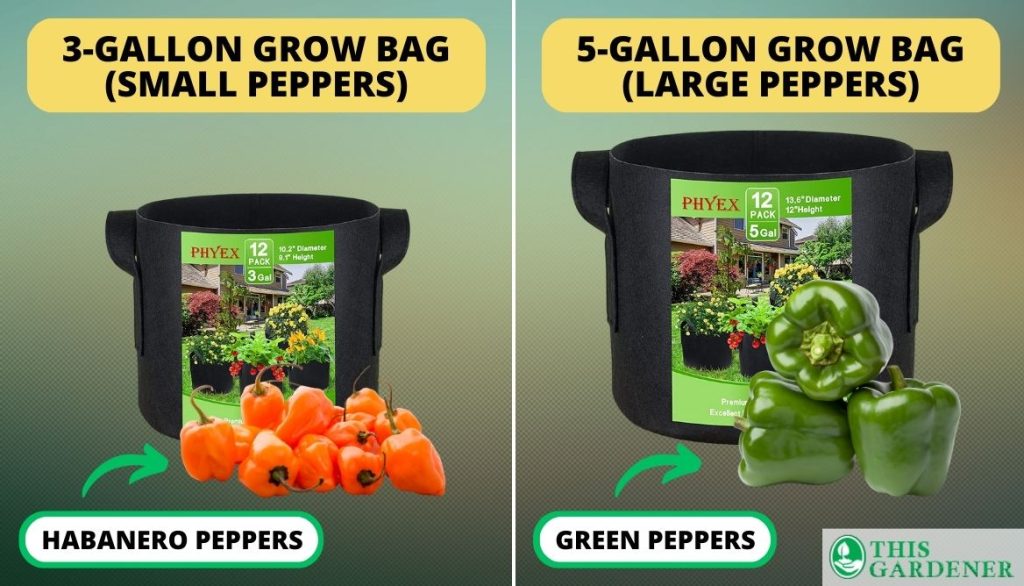
Depending on the type of pepper plant you choose, you should grow peppers in agrow bag of at least 5 gallons in size. We have discussed the sizes of grow bags suitable for various varieties below.
3+ Gallons/11+ Litres (Small Peppers)
You should use 3-gallon grow bags for smaller pepper varieties, like habanero (hot pepper variety) or ghost peppers.
Bell peppers can grow in 3-gallon size grow bags as well, but they may not produce as much because the larger the pot for peppers, the larger the output.
5+ Gallons/19+ Litres (Large Sized Peppers)
A 5-gallon grow bag is the best size to grow peppers. This size gives one pepper plant ample area to grow while still allowing it to move around effortlessly. Use larger bags with 5 gallons or more for larger kinds such as green peppers and jalapenos, etc.
Fabric Planter Grow Bags
Fabric plant bags are made of breathable fabric and porous polypropylene material. Some bags are constructed of woven fabric, which provides superior temperature stability, and a longer-lasting structure for a pepper plant.
- Cloth grow bags are inexpensive, collapsible, and easy to store after the growing plants season is through.
- The most significant advantages of fabric grow bag is better air circulation and a drainage system.
- Fabric grow bags usually have micro drainage holes suitable for plant peppers growth because they prevent overwatering and root rot.
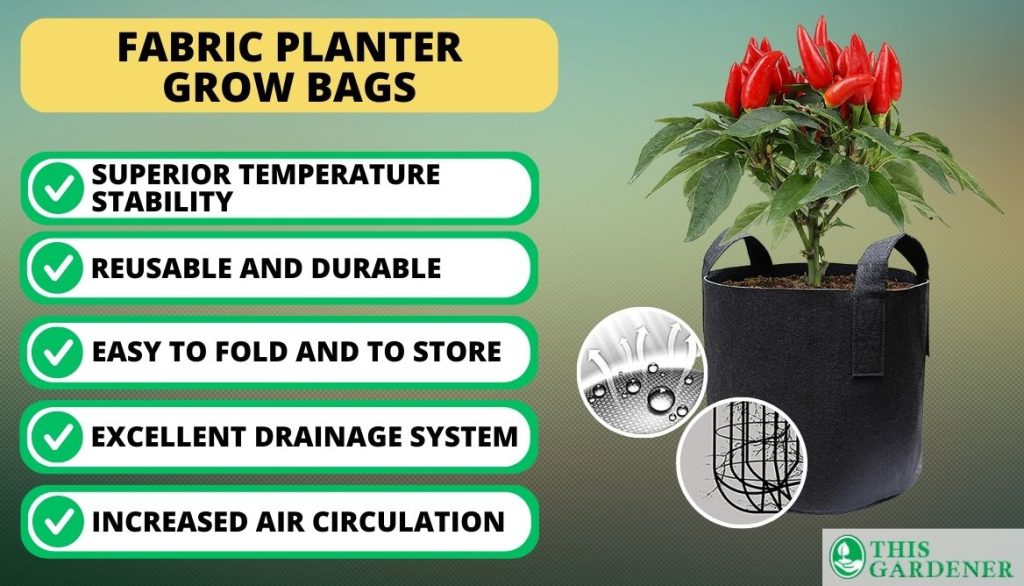
How Many Peppers to Grow in a 5-Gallon Bag?
One pepper plant will thrive in a 5-gallon plant container, and you can grow plants in the same bag until they are fully mature.
When using a larger grow bag, you can plant two pepper plants or more in it. You can plant the two smaller varieties of pepper plants in 5-gallon grow bags or in separate 3-gallons grow bags.
The Pros and Cons of Grow Bags for Peppers
Grow bags are an excellent medium for planting peppers and offer a number of advantages when using them, but everything has a good and a bad side.
We’ll go over the benefits and drawbacks in detail to ensure you make the best decision on whether grow bags are perfect for you and make the best of your harvest. Now, let’s go over them one at a time.
- Growth for a Better Root System
Grow bags are the finest way to help your peppers grow robust since they assist their root crops system because of their permeable nature. It helps the peppers grow by preventing erosion and delivering nutrients.
- Excellent Drainage
Grow bags‘ porous nature allows for excellent drainage. This allows water, air, and particles to pass through no matter the quantity you pour on the plant.
- They Can be Easily Stored
Grow bags are simply collapsible and easy to store due to their small weight and folding nature. They take up less storage space.
- Multiple Sizes and Different Colors
The most intriguing feature of employing grow bags is that they make your yard colorful aside from the color of your plant. They are available in a variety of colors and sizes to fit your preferences and demands.
But climate can also influence the choice of grow bag color. Dark-colored grow bags are ideal for chilly climates, whereas lighter colors are ideal for warm climates. The lighter colors absorb less sunlight, and dark hues draw more sunshine.
- More Surface Area
Grow bags are a great option if you don’t have enough space for an in-ground garden and come in sizes ranging from 1 to 200+ gallons filled with potting soil.
Grow bags come in a variety of heights and widths, making them adaptable to practically any plant size.
- Seedlings are Unlikely to be Root Bound
Grow bags do not have this “root bound” effect on your pepper seedlings. Because you did not plant them in plastic pots or round containers, which causes the roots to coil while growing plants.
- Not as Pretty as Some Container Pots
Grow bags are not decorated or patterned in any way. They come in bright and dark colors with some common, but not amusing shapes that make them not as aesthetically pleasing as other plant containers filled with potting soil.
- Some Grow Bags are Flimsy
Grow bags can survive for a long period, though not as long as plastic containers or other materials. Some grow bags are composed of heavy-duty PE film and are lined with plastic, making them reusable and recyclable.
Some, on the other hand, are constructed of cloth and fabric material, which are easily prone to tears and may not last long.
- They Dry Out Quickly
One disadvantage of using grow bags is that they quickly dry up due to the elements. Water frequently and apply a layer of straw mulch on top of your garden soil to prevent drying out.
The mulch will provide a protective layer on top of your potting soil, shielding it from direct sun exposure. Mulch will also aid in the retention of moisture in your garden soil.
What Pepper Plants You Can Grow at Home?
You can cultivate infinite pepper varieties at home. This eventuality can make things difficult. Even so, a few factors such as choice, environment, space, and availability can be useful when selecting pepper plants to grow.
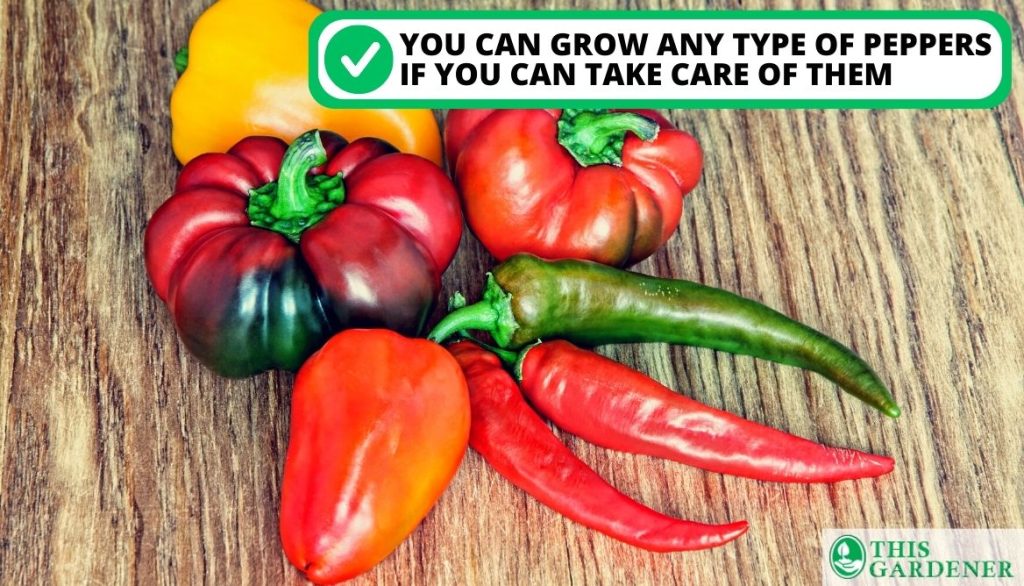
We have listed peppers you can grow at home in the list below, but there is no type you cannot plant as long as you can care for them.
- African Devil
- Habanero
- Serrano
- Scotch bonnet
- Fatalii
- Jamaican Hot
- Jalapeno Piñata
- Poblano
- Banana Pepper
- Jaloro
- Purple Jalapeno
- Black Jalapeno
- White Peppers
- Green Peppers
- Ninja S10
Factors That Can Help to Choose the Pepper Plant to Grow at Home
There are a few factors to consider while deciding which type of pepper to grow, and these are choice, environment, space, and the availability of pepper seeds.
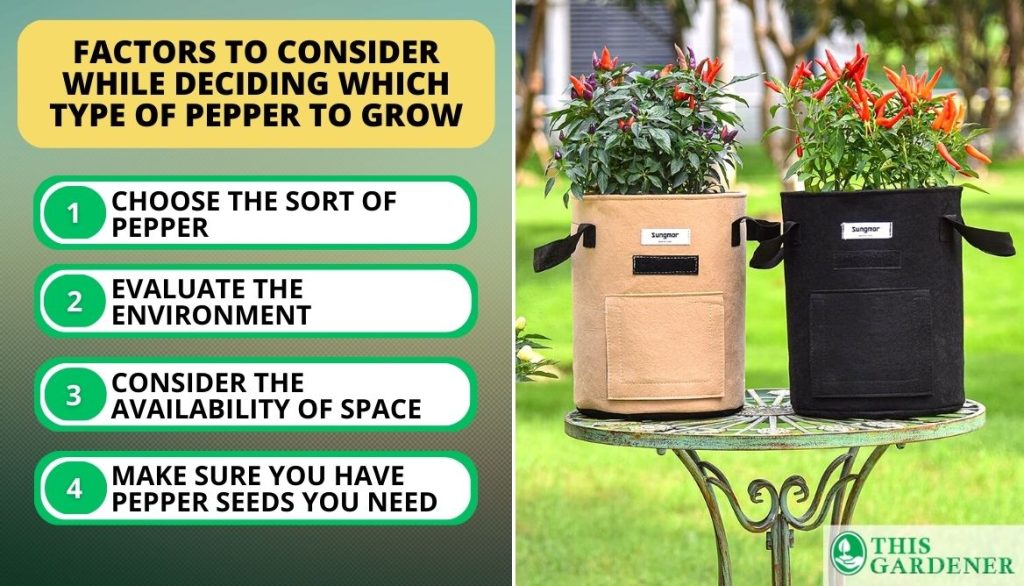
- Choice
These are your preferences and requirements. This determines the sort of pepper to plant based on what you consume and the pepper varieties you like as well as the colors you love to see in your garden.
- Environment
This refers to the climate and weather. While selecting pepper plants, evaluate the environment of your area to plant peppers so you can determine the weather requirements for the pepper you want to cultivate.
- Space
You should consider space when growing plants from two perspectives: your garden space and your capability to acquire appropriate grow bags.
Some pepper plants need a lot of room, while others don’t. Before planting, always consider the availability of space and the cost of purchasing bags.
- Availability of Pepper Seeds
Finally, there is the issue of pepper seed availability, whether you have pepper seeds at home or will buy them. You will only plant what you see that corresponds to your choice list.
Important Things to Take While Planting Pepper
While you are growing peppers at home, remember to take the following precautions.
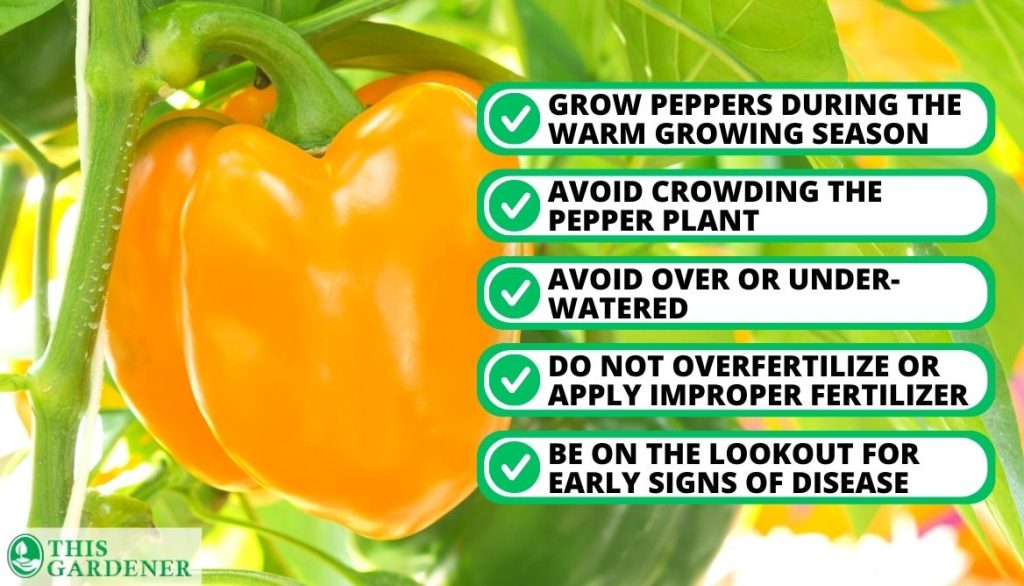
- Before planning, you should prepare the soil to ensure that nutrients can be fully actuated.
- Grow peppers, as soon as the weather warms up i.e during the warm growing season.
- Avoid crowding the pepper plant.
- The pepper plant should not be over or under-watered.
- Do not overfertilize or apply improper fertilizer on the pepper plant.
- Be on the lookout for early signs of disease and pest infestation.
- Timely harvesting of pepper fruit.
FAQ-Frequently Asked Question
How many pepper plants are in a 10-gallon grow bag?
10-gallon grow bag size can contain two pepper plants.
Are grow bags good for peppers?
Yes, grow bags are good for peppers for optimum growth and yield.
What size grow bag should I use?
The best size to use for a large variety of peppers is a 5-gallon size grow bag while 3-gallon size grow bags are suitable for smaller ones.
How deep do pepper roots grow?
Pepper roots can grow 18-4 inches deep.
Can I plant 2 pepper plants together?
Yes, you can plant it together but in larger containers like a 5-gallon grow bag.
Conclusion
Five different types of peppers can be planted in 3-5 gallon grow bags: green peppers, hot peppers, jalapenos, bell peppers, and banana peppers. Planting peppers in grow bags requires you to take a few things into account, such as soil, fertilizers, watering schedule, and pepper variety.
The best grow bag for growing peppers is a fabric 5-gallon grow bag because it can easily support a plant without compromising its natural qualities.
What variety of pepper will you like to plant? Please leave your preference in the comment section. Thanks for reading to the End.
- How to Get Potatoes to Sprout Eyes: Detailed Growing Guide with 3 Options - July 31, 2023
- Weight of a Medium Potato: Revealed in Detailed Guide - July 29, 2023
- Maris Piper Potatoes: 9 Substitutes You Should Know About - July 27, 2023
Hello! I’m Jessica Zander, a garden coach and consultant based in the Boston area (zone 6b), offering virtual consultations across the country and Canada.
I’ve been passionate about gardening since the early 1990s, and in 2022, I launched You Can Do It Gardening to empower individuals to feel more confident in their gardening endeavors.
Following a 30-year career in nonprofit finance and operations, I transitioned out of that field in mid-June of 2023 due to the growing demand for coaching services. Interestingly, my years of presenting financial statements to boards and finance committees proved to be valuable experience for teaching people about gardening! I enjoy sharing skills, providing guidance and suggestions, and collaborating efficiently with clients to make significant improvements to their outdoor spaces, both small and large. I also regularly teach at the Arlington Continuing Education and Cambridge Adult Education.
My approach is direct and practical, akin to Mary Poppins, but tailored to your garden. Clients find satisfaction in saving money and taking pride in their own gardening achievements.

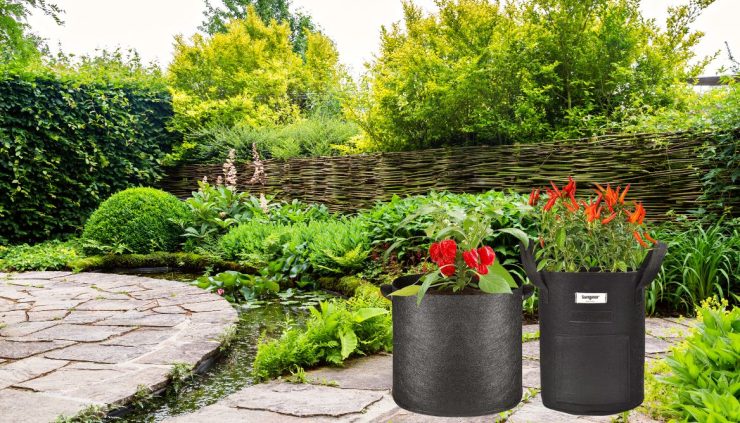






Add comment